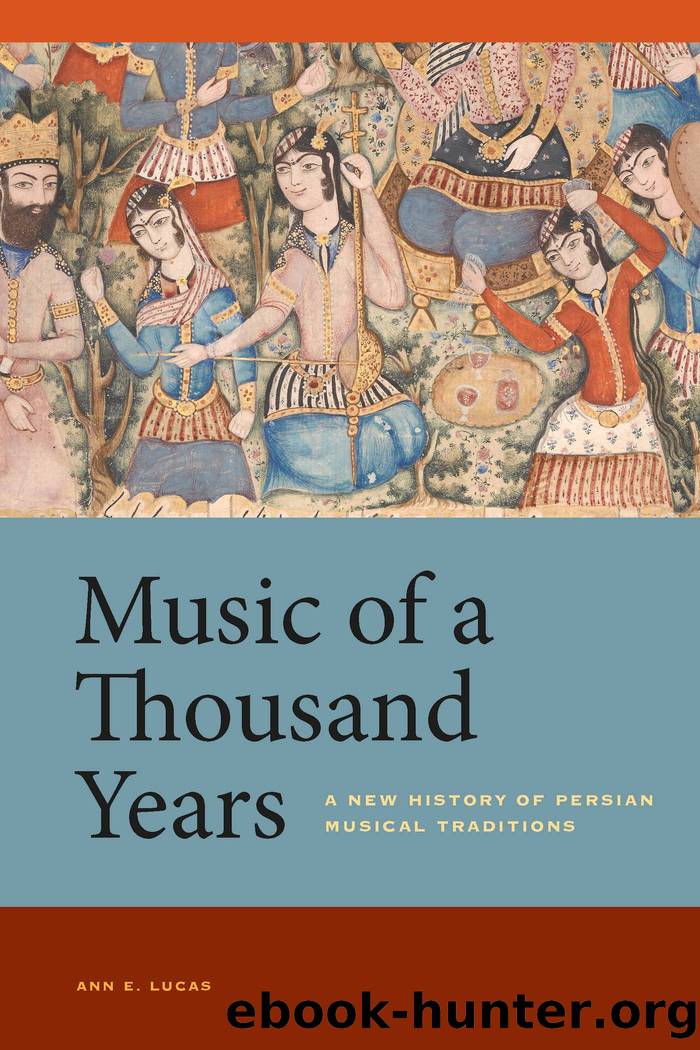Music of a Thousand Years by Ann E. Lucas

Author:Ann E. Lucas
Language: eng
Format: epub
ISBN: 9780520972032
Publisher: University of California Press
CONCLUSION
The radif-dastgah tradition emerged at the heart of the sudden and drastic transmutation of modern society in the nineteenth century. Its initial position at court and later position in the upper echelons of Iranâs modern urban landscape situated the practice and development of this music system at the heart of where modernity first emerged and developed in relation to the nation of Iran. Modernity created new public and private space as well as a new economic model and new types of social classes. The radif-dastgah tradition moved into and operated within the parameters of these major social, political, and economic transmutations.
These changes did not take hold everywhere in the Middle East at the same time. Initially, large portions of what became modern Iran were not experiencing the impacts of modern education or modern technology the way Tehran and other urban centers did. Many areas of Iran struggled to integrate into the global economy, even as the discovery of oil turned Iran into a de facto rentier state on the outermost edges of the economic system. Grand nationalization and modernization initiatives from both Reza Shah and Mohammad Reza Shah did not result in a uniform experience of modernity throughout the nation. But they did put a Pahalvian vision of Iran on the map and undermine any other nationalization efforts that questioned the legitimacy and the integrity of the Iranian nation.
This meant that, while urban elites could consistently imagine a uniformly Persian nation of Iran at the turn of the century, this Iranian national imagination was still in its early stages even by the 1920s. The movement of musicians who performed the radif-dastgah tradition from Qajar control into the modern educated elite positioned them to both experience and participate in the modernization process in its earliest manifestations. This early access related to their original place within the dynastic court and proximity to the dynastic aristocracy, where musicians related to government structures that were the focus of the first push for modernization. Courtiers took an interest in the tradition and courtiers were also some of the first to turn into and interface with the modern intelligentsia, even as they moved from being courtiers to operating in the national sphere.
In this context, the radif-dastgah tradition came out of a unique moment in history. Political and military contingencies of the eighteenth century interrupted the continuity of past court music traditions, opening up space for new traditions during the earliest phases of Iranian nationalization. The radif-dastgah tradition presented unique musical opportunities to adapt to a new temporal space, as music now needed to relate to modern identities and experiences well beyond the parameters of the court. The foundations of the twelve-maqam system would no longer have the same meaning in this modern context, even as the idiosyncrasies of the radif-dastgah tradition came to define a unique Iranian identity in the modern world. Conversely, the twelve-maqam system itself would ultimately return to serve as a conceptual point of national interpretation and reinterpretation for the radif-dastgah tradition. As
Download
This site does not store any files on its server. We only index and link to content provided by other sites. Please contact the content providers to delete copyright contents if any and email us, we'll remove relevant links or contents immediately.
The Goal (Off-Campus #4) by Elle Kennedy(12430)
Kathy Andrews Collection by Kathy Andrews(10518)
Diary of a Player by Brad Paisley(6866)
What Does This Button Do? by Bruce Dickinson(5527)
Assassin’s Fate by Robin Hobb(5236)
Big Little Lies by Liane Moriarty(4880)
Pale Blue Dot by Carl Sagan(4001)
Sticky Fingers by Joe Hagan(3454)
The Heroin Diaries by Nikki Sixx(2930)
The Death of the Heart by Elizabeth Bowen(2901)
Beneath These Shadows by Meghan March(2718)
The Help by Kathryn Stockett(2703)
Confessions of a Video Vixen by Karrine Steffans(2673)
How Music Works by David Byrne(2524)
Jam by Jam (epub)(2486)
Harry Potter 4 - Harry Potter and The Goblet of Fire by J.K.Rowling(2416)
Strange Fascination: David Bowie: The Definitive Story by David Buckley(2367)
Petty: The Biography by Warren Zanes(2237)
Darker Than the Deepest Sea by Trevor Dann(2206)
